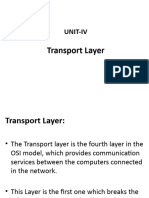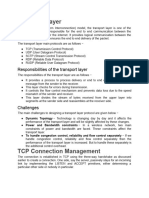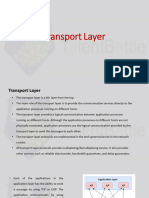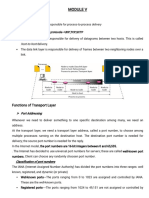0% found this document useful (0 votes)
40 views13 pagesCN Module4
The document discusses the transport layer in networking. It describes what the transport layer is, the main services it provides like process-to-process communication, multiplexing, flow control, data integrity and congestion avoidance. It then explains the two main transport layer protocols - UDP and TCP, describing their key characteristics and differences.
Uploaded by
Priya RanaCopyright
© © All Rights Reserved
We take content rights seriously. If you suspect this is your content, claim it here.
Available Formats
Download as DOCX, PDF, TXT or read online on Scribd
0% found this document useful (0 votes)
40 views13 pagesCN Module4
The document discusses the transport layer in networking. It describes what the transport layer is, the main services it provides like process-to-process communication, multiplexing, flow control, data integrity and congestion avoidance. It then explains the two main transport layer protocols - UDP and TCP, describing their key characteristics and differences.
Uploaded by
Priya RanaCopyright
© © All Rights Reserved
We take content rights seriously. If you suspect this is your content, claim it here.
Available Formats
Download as DOCX, PDF, TXT or read online on Scribd
/ 13































































